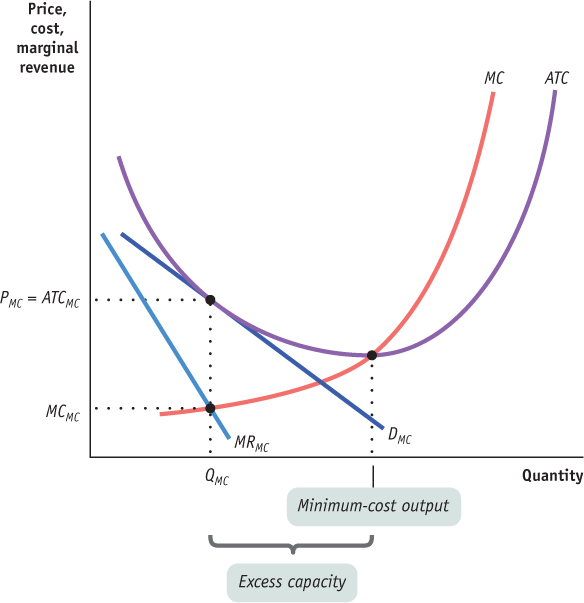1.4 34Monopolistic Competition

WHAT YOU WILL LEARN
 How prices and profits are determined in monopolistic competition, both in the short run and in the long run
How prices and profits are determined in monopolistic competition, both in the short run and in the long run
 How monopolistic competition can lead to inefficiency and excess capacity
How monopolistic competition can lead to inefficiency and excess capacity
Understanding Monopolistic Competition
Suppose an industry is monopolistically competitive: it consists of many producers, all competing for the same consumers but offering differentiated products. There is also free entry into and exit from the industry in the long run. How does such an industry behave?
As the term monopolistic competition suggests, this market structure combines some features typical of monopoly with others typical of perfect competition. Because each firm is offering a distinct product, it is in a way like a monopolist: it faces a downward-
However, unlike a pure monopolist, a monopolistically competitive firm does face competition: the amount of its product it can sell depends on the prices and products offered by other firms in the industry.
The same, of course, is true of an oligopoly. In a monopolistically competitive industry, however, there are many producers, as opposed to the small number that defines an oligopoly. This means that the “puzzle” of oligopoly—
So in situations of monopolistic competition, we can safely assume that firms behave noncooperatively and ignore the potential for collusion.
Monopolistic Competition in the Short Run
We introduced the distinction between short-
Panels (a) and (b) of Figure 34-1 show two possible situations that a typical firm in a monopolistically competitive industry might face in the short run. In each case, the firm looks like any monopolist: it faces a downward-
FIGURE34-1The Monopolistically Competitive Firm in the Short Run
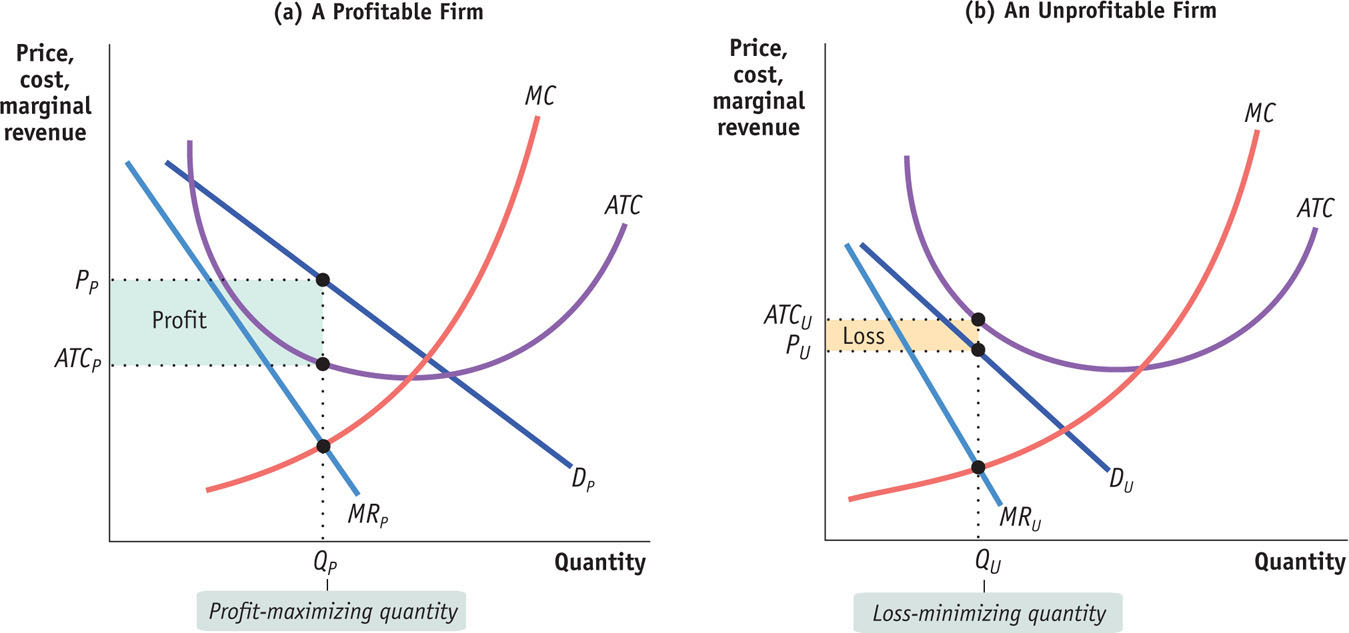
We assume that every firm has an upward-
In each case the firm, in order to maximize profit, sets marginal revenue equal to marginal cost. So how do these two figures differ? In panel (a) the firm is profitable; in panel (b) it is unprofitable. (Recall that we are referring always to economic profit and not accounting profit—
In panel (a) the firm faces the demand curve DP and the marginal revenue curve MRP. It produces the profit-
In panel (b) the firm faces the demand curve DU and the marginal revenue curve MRU. It chooses the quantity QU at which marginal revenue is equal to marginal cost. However, in this case the price PU is below the average total cost ATCU; so at this quantity the firm loses money. Its loss is equal to the area of the shaded rectangle. Since QU is the profit-
As this comparison suggests, the key to whether a firm with market power is profitable or unprofitable in the short run lies in the relationship between its demand curve and its average total cost curve. In panel (a) the demand curve DP crosses the average total cost curve, meaning that some of the demand curve lies above the average total cost curve. So there are some price–
In panel (b), by contrast, the demand curve DU does not cross the average total cost curve—
These figures, showing firms facing downward-
Monopolistic Competition in the Long Run
Obviously, an industry in which existing firms are losing money, like the one in panel (b) of Figure 34-1, is not in long-
It may be less obvious that an industry in which existing firms are earning profits, like the one in panel (a) of Figure 34-1, is also not in long-
How will entry or exit by other firms affect the profit of a typical existing firm? Because the differentiated products offered by firms in a monopolistically competitive industry are available to the same set of customers, entry or exit by other firms will affect the demand curve facing every existing producer.
If new gas stations open along a highway, each of the existing gas stations will no longer be able to sell as much gas as before at any given price. So, as illustrated in panel (a) of Figure 34-2, entry of additional producers into a monopolistically competitive industry will lead to a leftward shift of the demand curve and the marginal revenue curve facing a typical existing producer.
FIGURE34-2Entry and Exit Shift Existing Firms’ Demand Curves and Marginal Revenue Curves
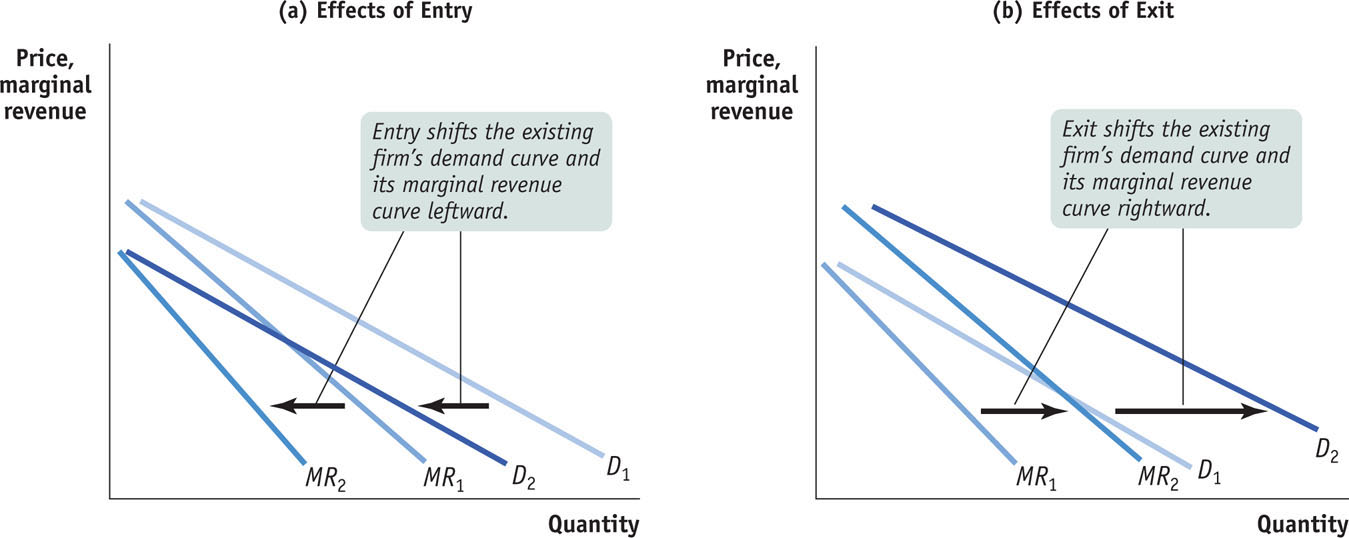
Conversely, suppose that some of the gas stations along the highway close. Then each of the remaining stations will be able to sell more gasoline at any given price. So as illustrated in panel (b), exit of firms from an industry leads to a rightward shift of the demand curve and marginal revenue curve facing a typical remaining producer.
In the long run, a monopolistically competitive industry ends up in zero-
The industry will be in long-
We have seen that a firm facing a downward-
If this is not the case, the firm operating at its profit-
In the case of a profit, new firms will enter the industry, shifting the demand curve of every existing firm leftward until all profit is eliminated. In the case of a loss, some existing firms exit and so shift the demand curve of every remaining firm to the right until all losses are eliminated. All entry and exit ceases only when every existing firm makes zero profit at its profit-
Figure 34-3 shows a typical monopolistically competitive firm in such a zero-
FIGURE34-3The Long-Run Zero-Profit Equilibrium
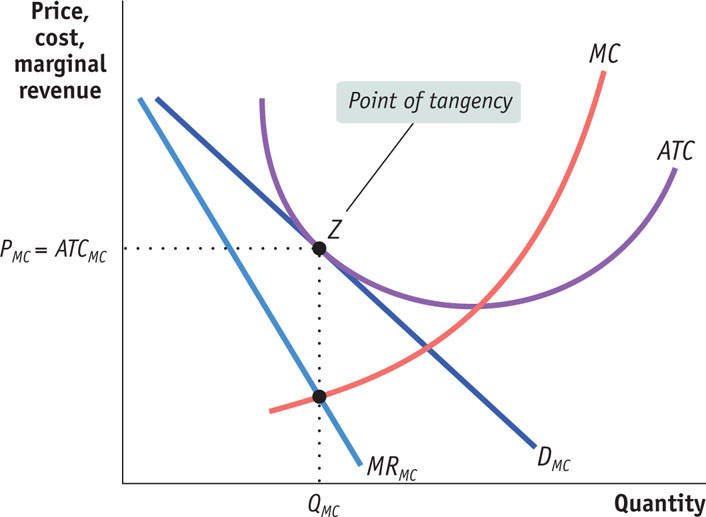
The normal long-
THE HOUSING BUST AND THE DEMISE OF THE 6% COMMISSION
The vast majority of home sales in the United States are transacted with the use of real estate agents. A home-
Traditionally, agents were paid by the seller: a commission equal to 6% of the sales price of the house, which the seller’s agent and the buyer’s agent would split equally. If a house sold for $300,000, for example, the seller’s agent and the buyer’s agent each received $9,000 (equal to 3% of $300,000).
The real estate brokerage industry fits the model of monopolistic competition quite well: in any given local market, there are many real estate agents, all competing with one another, but the agents are differentiated by location and personality as well as by the type of home they sell (whether condominiums, very expensive homes, and so on). And the industry has free entry: it’s relatively easy for someone to become a real estate agent (take a course and then pass a test to obtain a license).

But for a long time there was one feature that didn’t fit the model of monopolistic competition: the fixed 6% commission that had not changed over time and was unaffected by the ups and downs of the housing market.
You may wonder how agents were able to maintain the 6% commission. Why didn’t new agents enter the market and drive the commission down to the zero-
But protecting the 6% commission was always an iffy endeavor because any action by the brokerage industry to fix the commission rate at a given percentage would run afoul of antitrust laws. And by the early to mid-
In fact, oversight by regulators and the housing market bust which began in 2006 hastened the demise of the non-
Monopolistic Competition versus Perfect Competition
In a way, long-
However, the two versions of long-
Price, Marginal Cost, and Average Total Cost
Figure 34-4 compares the long-
First, in the case of the perfectly competitive firm shown in panel (a), the price, PPC, received by the firm at the profit-
This difference translates into a difference in the attitude of firms toward consumers. A wheat farmer, who can sell as much wheat as he likes at the going market price, would not get particularly excited if you offered to buy some more wheat at the market price. Since he has no desire to produce more at that price and can sell the wheat to someone else, you are not doing him a favor.
But if you decide to fill up your tank at Jamil’s gas station rather than at Katy’s, you are doing Jamil a favor. He is not willing to cut his price to get more customers—
The fact that monopolistic competitors, unlike perfect competitors, want to sell more at the going price is crucial to understanding why they engage in activities like advertising that help increase sales.
FIGURE34-4Comparing Long-Run Equilibrium in Perfect Competition and Monopolistic Competition
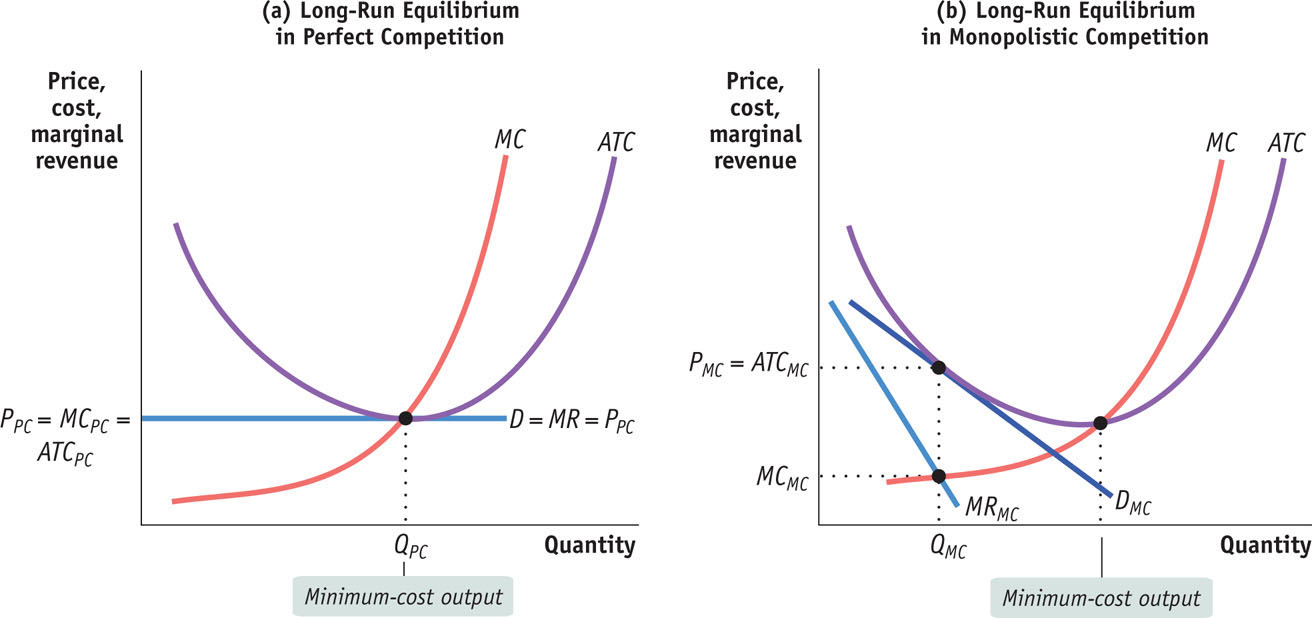
The other difference between monopolistic competition and perfect competition that is visible in Figure 34-4 involves the position of each firm on its average total cost curve. In panel (a), the perfectly competitive firm produces at point QPC, at the bottom of the U-
Firms in a monopolistically competitive industry have excess capacity: they produce less than the output at which average total cost is minimized.
Under monopolistic competition, in panel (b), the firm produces at QMC, on the downward-
Some people have argued that, because every monopolistic competitor has excess capacity, monopolistically competitive industries are inefficient. But the issue of efficiency under monopolistic competition turns out to be a subtle one that does not have a clear answer.
Is Monopolistic Competition Inefficient?
A monopolistic competitor, like a monopolist, charges a price that is above marginal cost. As a result, some people who are willing to pay at least as much for an egg roll at Wonderful Wok as it costs to produce it are deterred from doing so. In monopolistic competition, some mutually beneficial transactions go unexploited.
Furthermore, it is often argued that monopolistic competition is subject to a further kind of inefficiency: that the excess capacity of every monopolistic competitor implies wasteful duplication because monopolistically competitive industries offer too many varieties. According to this argument, it would be better if there were only two or three vendors in the food court, not six or seven. If there were fewer vendors, they would each have lower average total costs and so could offer food more cheaply.

Is this argument against monopolistic competition right—
There is, in other words, a trade-
34
Solutions appear at the back of the book.
Check Your Understanding
1. Suppose a monopolistically competitive industry composed of firms with U-
-
a. a technological change that increases fixed cost for every firm in the industry
An increase in fixed cost shifts the average total cost curve upward. In the short run, firms incur losses because price is below average total cost. In the long run, some firms will exit the industry, resulting in a rightward shift of the demand curves for those firms that remain, since each firm now serves a larger share of the market. Long-run equilibrium is reestablished when the demand curve for each remaining firm has shifted rightward to the point where it is tangent to the firm’s new, higher average total cost curve. At this point each firm’s price just equals its average total cost, and each firm makes zero profit. -
b. a technological change that decreases marginal cost for every firm in the industry
A decrease in marginal cost shifts the average total cost curve and the marginal cost curve downward. In the short run, firms earn positive economic profit. In the long run new entrants are attracted into the industry by the profit. This results in a leftward shift of each existing firm’s demand curve because each firm now has a smaller share of the market. Long-run equilibrium is reestablished when each firm’s demand curve has shifted leftward to the point where it is tangent to the new, lower average total cost curve. At this point each firm’s price just equals average total cost, and each firm makes zero profit.
2. Why is it impossible for firms in a monopolistically competitive industry to join together to form a monopoly that is capable of maintaining positive economic profit in the long run?
3. Are the following statements true or false? Explain your answers.
-
a. Like a firm in a perfectly competitive industry, a firm in a monopolistically competitive industry is willing to sell a good at any price that equals or exceeds marginal cost.
False. As illustrated in panel (b) of Figure 34.4, a monopolistically competitive firm sells its output at a price that exceeds marginal cost—unlike a perfectly competitive firm, which sells at a price equal to marginal cost. -
b. Suppose there is a monopolistically competitive industry in long-
run equilibrium that possesses excess capacity. All the firms in the industry would be better off if they merged into a single firm and produced a single product, but whether consumers would be made better off by this is ambiguous. True. Firms in a monopolistically competitive industry could achieve higher profit (monopoly profit) if they all joined together as a single firm with a single product. Because each of the smaller firms possesses excess capacity, a single firm producing a larger quantity would have a lower average total cost. The effect on consumers, however, is ambiguous. They would experience less choice. But if consolidation substantially reduced industry-wide average total cost and increases industrywide output, consumers could experience lower prices with the monopoly. -
c. Fads and fashions are more likely to arise in industries characterized by monopolistic competition or oligopoly than in those characterized by perfect competition or monopoly.
True. Fads and fashions are promulgated by advertising and a desire for product differentiation, which are common in oligopolies and monopolistically competitive industries, but not in monopolies or perfectly competitive industries.
Multiple-
Question
1. Which of the following is a characteristic of monopolistic competition?
| A. |
| B. |
| C. |
| D. |
| E. |
Question
2. Which of the following results is possible for a monopolistic competitor in the short run?
I. positive economic profit
II. normal profit
III. loss
| A. |
| B. |
| C. |
| D. |
| E. |
Question
3. Which of the following results is possible for a monopolistic competitor in the long run?
I. positive economic profit
II. normal profit
III. loss
| A. |
| B. |
| C. |
| D. |
| E. |
Question
4. Which of the following best describes a monopolistic competitor’s demand curve?
| A. |
| B. |
| C. |
| D. |
| E. |
Question
5. The long-
| A. |
| B. |
| C. |
| D. |
| E. |
Critical-
Draw a correctly labeled graph for a monopolistically competitive firm in long-
